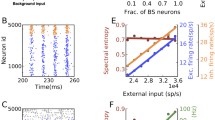Abstract
The discharge patterns of tonically-firing neurones are influenced by both the characteristics of their presynaptic input and their intrinsic properties. The regularity of the discharge of motoneurones is thought to reflect their prominent post-spike afterhyperpolarization (AHP). When a motoneurone fires at steady mean rate, the distribution of interspike intervals is determined by the amplitude and frequency content of the synaptic noise together with the decrease in excitability following a spike due to AHP. This paper considers how motoneurone discharge statistics can be used to estimate AHP trajectories as well as a motoneurone’s sensitivity to excitatory input.
Access this chapter
Tax calculation will be finalised at checkout
Purchases are for personal use only
Preview
Unable to display preview. Download preview PDF.
Similar content being viewed by others
References
Clamann, P. H., 1969, Statistical analysis of motor unit firing patterns in a human skeletal muscle, Biophysical Journal, 9, 1233–1251.
Kernell, D., 1965, The limits of firing frequency in cat lumbosacral motoneurones possessing different time course of afterhyperpolarization, Acta Physiologica Scandinavica, 65, 87–100.
Matthews,P. B. C., 1996, Relationship of firing intervals of human motor units to the trajectory of post-spike after-hyperpolarization and synaptic noise, Journal of Physiology, 492, 597–628.
Matthews, P. B. C., 1999, The effect of firing on the excitability of a model motoneurone and its implications for cortical stimulation, Journal of Physiology, 518, 867–882.
Person, R. S., and Kudina, L. P, 1972, Discharge frequency and discharge pattern of human motor units during voluntary contraction of muscle, Electroencephalography & Clinical Neurophysiology, 32, 471–483.
Piotrkiewicz, M., 1999, An influence of afterhyperpolarization on the pattern of motoneuronal rhythmic activity, Journal de Physiologie, 93, 125–133.
Pinsky, P. F., and Rinzel, J., 1994, Intrinsic and network rhythmogenesis in a reduced Traub model for CA3 neurons, Journal of Computer Neuroscience,I, 39–60.
Poliakov, A. V., Powers, R. K., and Binder, M. D., 1997, Functional identification of the input-output transforms of motoneurones in the rat and cat, Journal of Physiology, 504, 401–424.
Powers, R. K., and Binder, M. D., 2000, Relationship between the time course of the afterhyperpolarization and discharge variability in cat spinal motoneurones, Journal of Physiology, 528, 131–150.
Tokizane, T., and Shimazu, H., 1964, Functional Differentiation of Human Skeletal Muscle, University of Tokyo Press, Tokyo.
Turker, K. S., 1995, The shape of the membrane potential trajectory in tonically-active human motoneurons, Journal of Electromyography & Kinesiology, 5, 3–14.
Turker, K. S., and Powers, R. K., 2001, The effect of motoneuron discharge rate on synchronization, Society for Neuroscience, Abstract, 27, 625.9.
Author information
Authors and Affiliations
Editor information
Editors and Affiliations
Rights and permissions
Copyright information
© 2002 Springer Science+Business Media New York
About this chapter
Cite this chapter
Powers, R.K., Türker, K.S., Binder, M.D. (2002). What Can Be Learned About Motoneurone Properties from Studying Firing Patterns?. In: Gandevia, S.C., Proske, U., Stuart, D.G. (eds) Sensorimotor Control of Movement and Posture. Advances in Experimental Medicine and Biology, vol 508. Springer, Boston, MA. https://doi.org/10.1007/978-1-4615-0713-0_24
Download citation
DOI: https://doi.org/10.1007/978-1-4615-0713-0_24
Publisher Name: Springer, Boston, MA
Print ISBN: 978-1-4613-5206-8
Online ISBN: 978-1-4615-0713-0
eBook Packages: Springer Book Archive




